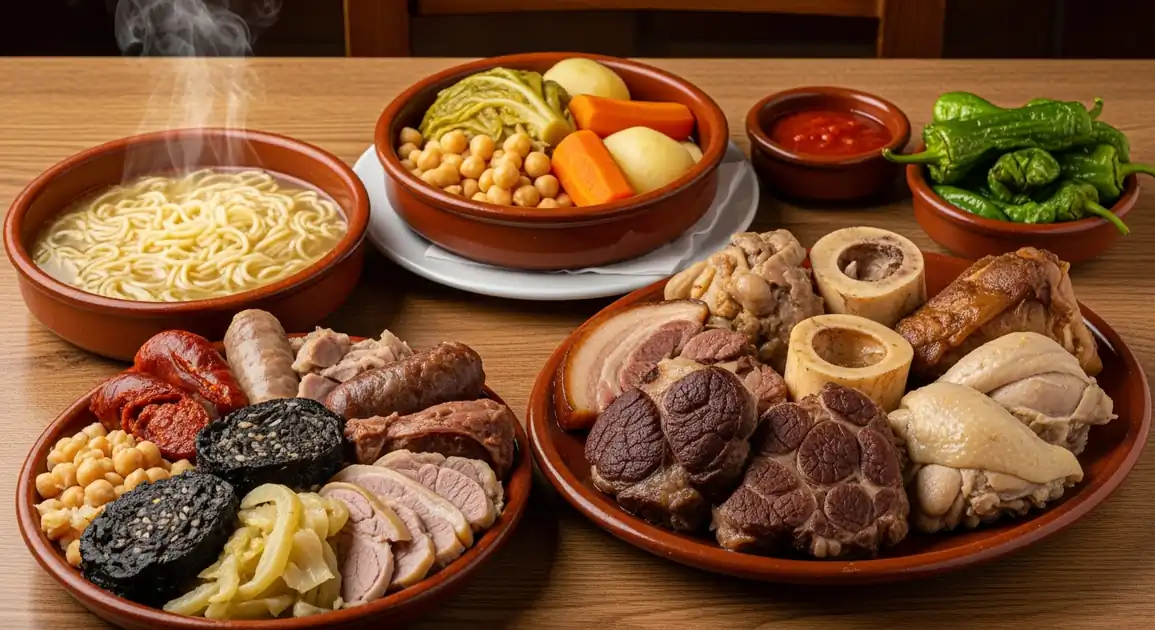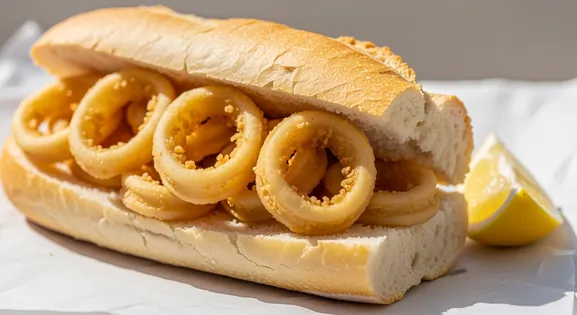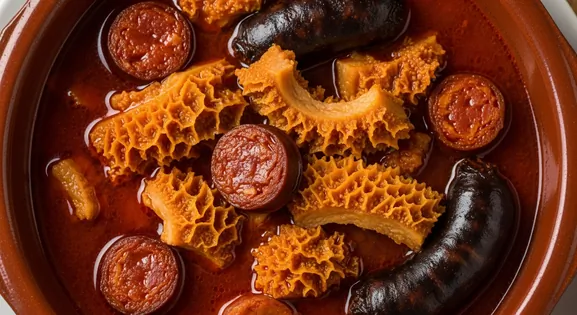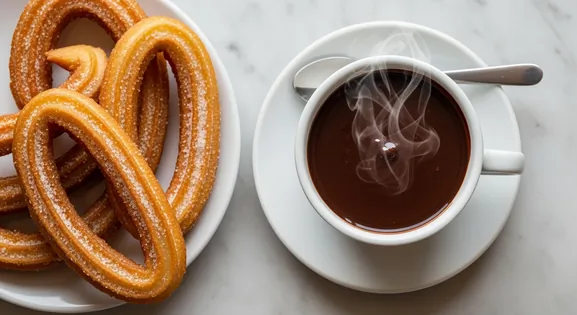Cocido Madrileño in Madrid
Cocido Madrileño

Discovering Authentic Cocido Madrileño
Stepping into a traditional Madrileño taberna on a chilly day, the aroma of slow-cooked Cocido Madrileño instantly transports you. This isn't just a meal; it's a deep dive into Madrid's culinary soul, a multi-course experience that warms you from the inside out and connects you to generations of local tradition.
New to Cocido Madrileño? Learn all about its history in our complete guide.
Unlocking the Secrets of a Great Meal
Many traditional Cocido spots in Madrid, especially the most renowned ones, reserve Wednesdays for this dish and get fully booked weeks in advance. Plan your visit accordingly.
Cocido is served in three distinct 'vuelcos' (courses). Don't rush or mix them. Savor the broth first, then the chickpeas and vegetables, and finally the meats. It's part of the authentic Madrid experience.
Many Madrileños enjoy their Cocido with pickled green peppers ('guindillas') and a special tomato sauce often seasoned with cumin. These condiments add a delightful zing and are a local touch.
Navigating the City for Great Cocido Madrileño
Centro (Sol, La Latina, Austrias)
Home to many iconic Cocido restaurants like Malacatín, Lhardy, La Bola Taberna. Requires booking.
Plaza Mayor, Puerta del Sol, Royal Palace
Lunch (Winter)
Chamberí / Salamanca
These elegant districts boast a selection of refined, traditional restaurants where Cocido Madrileño is prepared with meticulous care, often featuring a more gourmet approach to the classic stew.
Calle Ponzano, Serrano Street, Retiro Park vicinity
Lunch (Winter)
Various Neighborhoods ('Barrios')
Authentic, less touristy 'casas de comidas' can be found across different Madrid neighborhoods offering excellent Cocido.
Local markets, Residential areas
Lunch (Winter, often specific days)
Vendor Tips
- Reservations are essential for well-known places, often weeks in advance.
- Famous spots: La Bola (cooked in individual clay pots), Malacatín (known for huge portions), Lhardy (historic luxury), Casa Carola (serve-yourself quantities).
- Ask locals for their favorite neighborhood spot for a potentially more low-key experience.
- Verify serving days; many only offer it 1-3 days a week, even in winter.
Authentic vs Imitation: The Telltale Signs
What to Look For
-
Restaurants serving the 'sopa' (broth) steaming hot, even in winter
In Madrid's traditional 'casas de comidas', serving the initial broth piping hot is a key indicator of freshness and adherence to safe holding temperatures, crucial for slow-cooked dishes.
-
Vendors using separate ladles for broth, chickpeas, and meats
Observing this practice, common in meticulous Madrid establishments, minimizes cross-contamination risk between the 'vuelcos'.
-
Clear, firm chickpeas ('garbanzos')
Quality Madrid cocido features chickpeas that hold their shape, indicating proper cooking and good ingredient quality, often Pedrosillano variety.
-
Specific mention of sourcing for meats like 'morcilla' or chorizo
Better Madrid restaurants often highlight the origin or type of their cured meats, suggesting higher quality control.
What to avoid
-
Cocido offered 'express' or all courses served simultaneously
Authentic Madrid cocido requires slow cooking and sequential serving ('vuelcos'); rushed versions may compromise cooking thoroughness and temperature safety.
-
Lukewarm broth or chickpeas, especially during colder months (Oct-Mar)
Temperature control is vital. Food held below 60°C (140°F) can breed bacteria. This is a key focus for traditional Madrid eateries.
-
Restaurants around major tourist squares (Plaza Mayor, Sol) advertising cheap 'Cocido Express'
While not always bad, these tourist-focused offers in Madrid often prioritize speed over the authentic, slow-cooked quality and safety inherent in traditional preparation.
-
Cloudy broth or mushy chickpeas
Can indicate overcooking, old ingredients, or poor handling, impacting both quality and potentially freshness in Madrid's demanding food scene.
The Traveler's Essentials
Dietary Information
Important Note for Travelers: Your safety is our priority. Below are the common allergens associated with the traditional preparation of this dish. However, recipes and ingredients can vary significantly between establishments. Always confirm all ingredients directly with the food vendor before ordering, especially if you have a severe allergy.
Potential Allergens
Dietary Suitability
Price Guide
Budget Tips
- Prices range from around 22 EUR in simpler neighborhood spots to over 50 EUR in historic, high-end establishments like Lhardy.
- Look for 'Menú de Cocido' which usually includes bread, drink, and dessert/coffee.
- Wednesday prices might sometimes be slightly lower in certain places, but usually it's a fixed price regardless of the day offered.
Serving & Seasonality
Strictly served in three courses ('vuelcos'). Served piping hot. Portions are typically very generous.Best Times to Enjoy
- Lunch (Weekday): Especially popular on Wednesdays in many traditional spots (1:30 PM - 4 PM).
- Lunch (Weekend): Common for Sunday family lunches (1:30 PM - 4 PM).
Seasonal Availability
Peak season is winter (October-April). Some places might offer it year-round, but it's less common and less traditional in summer.
Ordering Like a Local
When ordering Cocido in Madrid, simply ask for "un cocido completo." Be aware that it's a substantial meal, so consider sharing if you're not extremely hungry. Don't be surprised if the waiter brings the courses sequentially; this is the traditional "vuelcos" style. If you have dietary restrictions, it's best to inquire beforehand, as the dish is meat-heavy. Many places offer a "Menú del Día" that includes Cocido on specific days, often Wednesdays.
Local Styles of Cocido Madrileño
Restaurant Specialties
While the core is the same, each famous Cocido restaurant in Madrid has subtle differences in broth flavor, meat selection, chickpea tenderness, or accompanying condiments.
'Relleno' Presence
Some Madrid institutions always include the 'relleno' (bread dumpling), while others omit it.
Condiment Offerings
Some offer specific tomato sauces (often with cumin), pickled peppers (guindillas), or raw onion/chives alongside.
The Role of Cocido Madrileño in Local Culture
Local Significance
Cocido is arguably Madrid's most emblematic dish. Eating it is participating in a local ritual, a culinary tradition passed down through generations.
Eating Customs
- Do not mix the courses.
- Use bread to mop up broth or juices.
- Often accompanied by robust Spanish red wine.
Mastering the Experience
Navigating Madrid's Cocido Scene
Learn how to identify and choose the best traditional establishments in Madrid to enjoy an authentic and high-quality Cocido Madrileño experience.
- Seek out traditional 'casas de comidas' or 'tabernas' in neighborhoods like La Latina, Chamberí, or near the Rastro market, known for specializing in cocido, rather than generic tourist restaurants.
- Book ahead, especially for lunch (1:30-3:30 PM) during 'cocido season' (roughly October to March) when demand in Madrid peaks.
- Observe the clientele – places popular with local Madrileños, especially older generations, usually signify authentic preparation and reliable quality.
- Be prepared for a large, slow meal. Allocate at least 1.5-2 hours and understand the three 'vuelcos' (courses) are served sequentially.
- Ask if they offer 'vuelco de carnes con repollo y patata' – the inclusion of cabbage and potato in the second/third vuelco is typical in Madrid.
Eating Cocido Like a Madrileño
Understand the traditional etiquette and sequential serving of Cocido Madrileño to fully appreciate this iconic Madrid dish as locals do.
- Start with the 'sopa' (broth with noodles), ensuring it's served steaming hot. Finish this before the next course arrives.
- For the 'segundo vuelco' (chickpeas and vegetables), it's common in Madrid to drizzle olive oil or mash chickpeas slightly. Ensure vegetables are tender.
- Pace yourself for the 'tercer vuelco' (meats). Expect a variety including chorizo, morcilla, beef shank, pork belly ('tocino'), and sometimes chicken or pig's ear. Ensure all look well-cooked.
- Pair with a robust red wine, often a Rioja Crianza or a local Vinos de Madrid recommendation.
- Don't be shy about leftovers ('sobras'); many Madrid locals take remaining meats home, and reputable places will pack them safely for you if asked.
Our Commitment to Quality
At Tasteplorers, our mission is to provide the most accurate and useful travel information in the world. To achieve this, all content on this site is created through our unique editorial framework. We utilize leading AI research tools, guided by our proprietary prompts, and a multi-stage validation process. This entire system is overseen by our editorial team to ensure everything we publish meets our high standards for accuracy, cultural nuance, and practical value for travelers.
Learn more about our Editorial Process and our Mission.
Countries
Explore regions
Europe
Discover Europe's diverse culinary landscape, from Mediterranean flavors to hearty Alpine fare. Learn to navigate markets, decode menus, and eat like a local.
Latin America & Caribbean
Discover the vibrant cuisines of Latin America & the Caribbean. Our expert guide covers everything from Mexican street food to Peruvian ceviche and market tips.
Oceania
Explore Oceania's diverse food scene. Learn about Polynesian earth ovens, Fijian feasts, and the vibrant café culture of Australia and New Zealand.
Southeast Asia
Explore Southeast Asia's diverse food cultures from Thailand to Vietnam. Get expert tips on navigating spice levels, choosing quality vendors, and understanding the rich traditions of the region.


